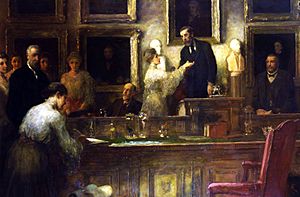Marian Farquharson facts for kids
Quick facts for kids
Marian Farquharson
|
|
|---|---|
 |
|
| Born | 2 July 1846 West Meon, Hampshire, England
|
| Died | 20 April 1912 (aged 65) Nice, France
|
| Resting place | Alford, Aberdeenshire |
| Education | at home |
| Spouse(s) |
Robert Francis Ogilvie Farquharson
(m. 1883; died 1890) |
| Parent(s) |
|
Marian Sarah Ogilvie Farquharson (born Ridley, 2 July 1846 – 20 April 1912) was a British naturalist and a champion for women's rights. A naturalist is someone who studies nature, including plants and animals.
She became the first woman to be a Fellow of the Royal Microscopical Society. This meant she was a member, but she was not allowed to attend meetings. Marian Farquharson is best known for fighting for women to have full membership in important scientific groups. These groups are often called "learned societies."
Early Life and Family
Marian Sarah Ridley was born on July 2, 1846, in West Meon, Hampshire, England. She was the oldest daughter of Nicholas James Ridley, who was a priest, and Frances Joucriet.
Marian was taught at home, which included music lessons. She soon became very interested in studying nature.
In 1883, she married Robert Francis Ogilvie Farquharson. She moved to live with him on his estate near Alford, Aberdeenshire in Scotland. Robert died in May 1890. After his death, Marian continued her interests in nature and in helping women join scientific societies.
Scientific Work
Marian Farquharson joined the Epping Forest and Essex Naturalists' Field Club in 1881. In the same year, she published her book, A Pocket Guide to British Ferns.
After moving to Scotland, she joined the Alford Field Club. She also joined the East of Scotland Union of Naturalists' Societies. Marian wrote two articles about ferns and mosses for a magazine called the Scottish Naturalist. She also gave a talk about these plants at a meeting in Aberdeen in 1885. This meeting was for the British Science Association.
In 1885, Marian was chosen as the first female Fellow of the Royal Microscopical Society. Even though she was a member, women were not allowed to attend any of the society's meetings. They also could not vote on important matters.
She was also involved with a big meeting called the Congress of the International Council of Women. This meeting happened in London in 1899. Marian helped with the part of the meeting that focused on biology.
Fighting for Women's Rights
After her husband died in 1890, Marian Farquharson started working hard for women's rights. She wanted women to have full membership and be able to take part in learned societies. She started a group called the Scottish Association for Promotion of Women's Public Work and became its president.
In 1900, Marian sent a letter to two important groups: the Royal Society and the Linnean Society of London. Her letter asked that "qualified women should have the advantages of full fellowship in scientific and other learned societies." This meant she wanted women to be able to join these groups completely.
The Linnean Society first said they could not accept her request. They said it had to come from one of their current members. So, a former president, John Lubbock, 1st Baron Avebury, sent the request for her. But the society still said no. They thought their rules might not allow women to be members. The Royal Society gave a similar answer.
The next year, Marian Farquharson kept pushing the Linnean Society. Finally, the society agreed to let its members vote on her request. In 1903, the society decided to ask the King for a special rule. This rule would clearly allow women to become members.
A vote for fifteen women to become members finally happened in December 1904. All of them were chosen except for Marian Farquharson. She was not elected to the society until 1908, when her name was put forward again. However, because of her health, she never signed the society's official list to become a member. She passed away in Nice on April 20, 1912.
Published Works
Besides her early interest in ferns and mosses, Marian also became interested in tiny water plants called desmids starting in 1883.
- A Pocket Guide to British Ferns (1881) (online)
- Notes on mosses of the north of Scotland in Scottish Naturalist, vol. 8, 1885–1886, p. 381 (online)
- Ferns and mosses of the Alford district in Scottish Naturalist, vol. 10, 1889–1890, pp. 193–198
See also
 In Spanish: Marian Farquharson para niños
In Spanish: Marian Farquharson para niños


